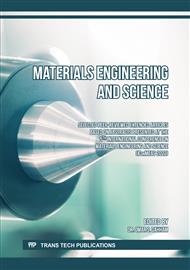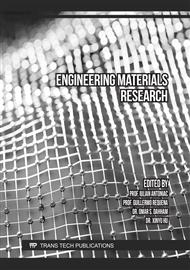[1]
M. Amapricio, A. Jitianu, G. Rodriguez, K. Al-Marzoki, M. Jitianu, J. Mosa and L.C. Klein, Thickness-properties synergy in organic–inorganic consolidated melting-gel coatings for protection of 304 stainless steel in NaCl solutions,, Surface and Coating Technology, 315 (2017) 426-436.
DOI: 10.1016/j.surfcoat.2017.02.059
Google Scholar
[2]
M. Bynu, Poly(vinylpyrrolidone)-modification of sol-gel films for flexible piezoelectric energy harvesting systems,, Thin Solid Films, 663 (2018) 31-36.
DOI: 10.1016/j.tsf.2018.08.014
Google Scholar
[3]
K.K. Saini, S.D. Sharma, Chanderkant, M. Kar, D. Singh and C.P. Sharma, Structural and optical properties of TiO2 thin films derived by sol–gel dip coating process,, Non-Crystal. Solids, 353 (2007) 2469-2473.
DOI: 10.1016/j.jnoncrysol.2006.12.017
Google Scholar
[4]
C.J. Brinker, G.C. Frye, A.J. Hurd and C.S. Ashley, Fundamentals of sol-gel dip coating,, Thin Solid Films, 201 (1991) 97-108.
DOI: 10.1016/0040-6090(91)90158-t
Google Scholar
[5]
L.C. Klein and A. Jitianu, Organic–inorganic hybrid melting gels,, J. Sol-Gel Science and Technology, 59 (2011) 424-431.
DOI: 10.1007/s10971-011-2414-y
Google Scholar
[6]
J. Malzbender and G. With, Fracture toughness of hybrid organic-inorganic coatings,, J. Mat. Sci. letters, 19 (2000) 1867-1868.
Google Scholar
[7]
S. Etienne-Calas, A. Duri and P. Etienne, Fracture study of organic–inorganic coatings using nanoindentation technique,, Non-Crystal. Solids, 344 (2004) 60-65.
DOI: 10.1016/j.jnoncrysol.2004.07.029
Google Scholar
[8]
P. Guo, X. Chen, X. Gao, H. Song and H. Shen, Fabrication and mechanical properties of well-dispersed multiwalled carbon nanotubes/epoxy composites,, Comp. Sci. Tech., 67 (2007) 3331-3337.
DOI: 10.1016/j.compscitech.2007.03.026
Google Scholar
[9]
A.A. Al-allaq, J.S. Kashan, M.T. El-Wakad and A.M. Soliman, Multiwall carbon nanotube reinforced HA/HDPE biocomposite for bone reconstruction,, Periodicals of Eng. Natural Sci., 9 (2021) 930-939.
DOI: 10.21533/pen.v9i2.1946
Google Scholar
[10]
A. May-Pat, F. Avilés, P. Toro, M. Yazdani-Pedram and J.V. Cauich-Rodríguez, Mechanical properties of PET composites using multi-walled carbon nanotubes functionalized by inorganic and itaconic acids,, eXPRESS Polymer Letters, 6 (2012) 96-106.
DOI: 10.3144/expresspolymlett.2012.11
Google Scholar
[11]
M. Mu, E. Teblum, Ł. Figiel, G.D. Nessim and T. McNally, Correlation between MWCNT aspect ratio and the mechanical properties of composites of PMMA and MWCNTs,, Mat. Research Express, 5 (2018) 045305.
DOI: 10.1088/2053-1591/aab82d
Google Scholar
[12]
G. Zhan and A.K. Mukherjee, Carbon nanotube Reinforced Alumina-Based Ceramics with novel mechanical, mechanical, electrical, and thermal Properties,, Intentional Journal of Applied Ceramic Technology, 1 (2004) 161-71.
DOI: 10.1111/j.1744-7402.2004.tb00166.x
Google Scholar
[13]
ASTM C1327-15(2019), Standard Test Method for Vickers Indentation Hardness of Advanced Ceramics, ASTM International, West Conshohocken, PA, 2019, www.astm.org.
Google Scholar
[14]
B.R. Lawn, A.G. Evans and D.B. Marshall, Elastic/plastic indentation damage in ceramics: The median/radial crack system,, J. Am. Cer. Soc., 63 (1980) 574–581.
DOI: 10.1111/j.1151-2916.1980.tb10768.x
Google Scholar
[15]
He Lvmeng, Surface treatments to tailor the wettability of carbon nanotube arrays,, MSc Thesis, Wright State University, (2011).
Google Scholar
[16]
C. Velasco-Santos, A.L. Martinez-Hernandez, W. Brostow and V.M. Castano, Influence of silanization treatment on thermomechanical properties of multiwalled carbon nanotubes: poly (methylmethacrylate) nanocomposites,, Nanomaterials, 2011 (2011) 928659.
DOI: 10.1155/2011/928659
Google Scholar
[17]
K.L. Mittal, Silanes and Other Coupling Agents,, Volume 3: Taylor & Francis London, (2004).
Google Scholar
[18]
R. Al-Oweini and H. El-Rassy, Synthesis and characterization by FTIR spectroscopy of silica aerogels prepared using several Si (OR) 4 and R'' Si (OR') 3 precursors,, J. Molec. Str., 919(2009) 140-145.
DOI: 10.1016/j.molstruc.2008.08.025
Google Scholar
[19]
C. Tsai, H. Lin, H. Tsai, J. Hwang, S. Chang and Y. Chen-Yang, Characterization and PEMFC application of a mesoporous sulfonated silica prepared from two precursors, tetraethoxysilane and phenyltriethoxysilane,, Inter. J. Hydrogen Energy, 36 (2011) 9831-9841.
DOI: 10.1016/j.ijhydene.2011.04.186
Google Scholar
[20]
M.D. Halls, C.P. Tripp and H.B. Schlegel, Structure and infrared (IR) assignments for the OLED material: N, N'-diphenyl-N, N'-bis (1-naphthyl)-1, 1'- biphenyl-4, 4 ''-diamine (NPB),, Phy. Chem. Chem. Phy., 3 (2001) 2131-2136.
DOI: 10.1039/b101619i
Google Scholar
[21]
A.V. Rao, R.R. Kalesh and G. Pajonk Hydrophobicity and physical properties of TEOS based silica aerogels using phenyltriethoxysilane as a synthesis component,, J. Mat. Sci., 38 (2003) 4407-4413.
Google Scholar
[22]
C. Alié, R. Pirard and J. Pirard,Preparation of low-density xerogels from mixtures of TEOS with substituted alkoxysilanes: II. Viscosity study of the sol–gel transition,, Non-Crystall. Solids, 320 (2003) 31-39.
DOI: 10.1016/s0022-3093(03)00082-6
Google Scholar



